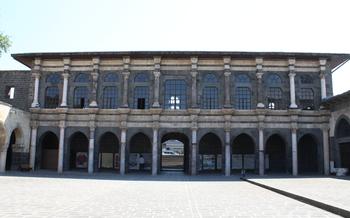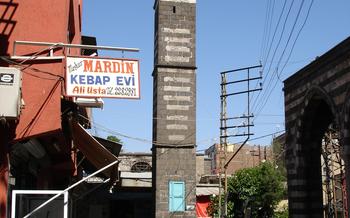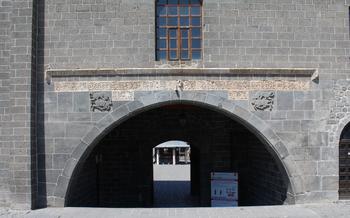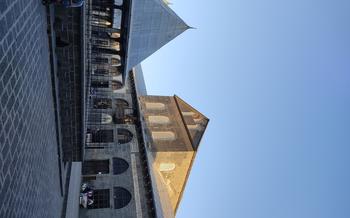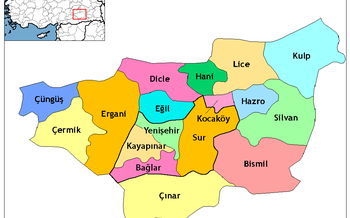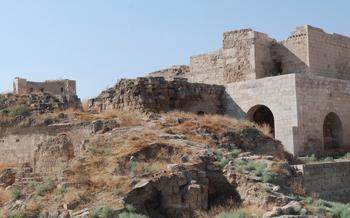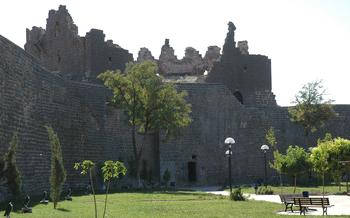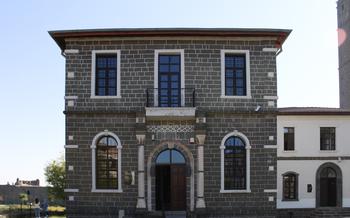
Diyarbakır Watermelon Sculpture
- History of the Watermelon Sculpture
- Location and Accessibility
- Appearance and Design
- Cultural Significance
- Symbolism and Interpretation
- Photo Opportunities
- Local Cuisine and Gastronomy
- Historical Context
- Art and Sculpture Appreciation
- Visitor Etiquette
- Local Crafts and Souvenirs
- Travel Tips
- Sustainability and Eco-Tourism
- Insider Tip:
History of the Watermelon Sculpture
In the heart of Diyarbakır, a vibrant city steeped in history and culture, lies a unique and captivating artwork that has become an emblem of the city's rich heritage - the Watermelon Sculpture. This striking sculpture, crafted from bronze, pays homage to the humble watermelon, a symbol of abundance, fertility, and prosperity in the local culture.
The artist behind this masterpiece, Mehmet Aksoy, drew inspiration from the deep cultural significance of the watermelon to the people of Diyarbakır. His vision was to create a symbol that would embody the essence of the city, celebrating its agricultural heritage and the central role that watermelons have played in its history.
The process of creating the watermelon sculpture was a labor of love and dedication. Aksoy meticulously studied the form and texture of watermelons, capturing their organic curves and vibrant colors in bronze. The result is a lifelike representation that exudes a sense of realism and authenticity.
Today, the watermelon sculpture stands as a proud symbol of Diyarbakır, a testament to the city's rich cultural heritage and its deep connection to the land and its produce. It serves as a reminder of the importance of agriculture and the sustenance it provides, while also celebrating the beauty and diversity of the natural world.
Location and Accessibility
The iconic Watermelon Sculpture is a must-see attraction in Diyarbakır, Turkey. Perfectly situated in the heart of the city, it stands proudly at the entrance of the renowned Koşuyolu Park. This vibrant green space is a popular spot for locals and tourists alike, offering a peaceful retreat from the bustling city streets.
To reach the Watermelon Sculpture, visitors have several convenient options. If you prefer public transportation, hop on the city bus that stops right outside the park. The sculpture is just a short walk from the bus stop, making it easily accessible for those exploring Diyarbakır on a budget.
For those who prefer the flexibility of exploring at their own pace, renting a car is a great option. Diyarbakır has a well-developed road network, making it easy to navigate. Once you arrive at Koşuyolu Park, ample parking is available, ensuring a hassle-free visit.
While visiting the Watermelon Sculpture, take advantage of the opportunity to explore the surrounding attractions. The park itself is home to a variety of other sculptures, playgrounds, and walking paths. Just a short stroll away, you'll find the historic Diyarbakır Fortress, a UNESCO World Heritage Site that offers a glimpse into the city's rich past.
Appearance and Design
The watermelon sculpture is a striking and unique work of art that captivates visitors with its intricate design and impressive dimensions. Carved from a single block of pink granite, the sculpture stands at an imposing height, towering over passersby. Its smooth, rounded contours mimic the shape of a watermelon, complete with a realistic rind and a vibrant red interior. The artist has skillfully captured the essence of this beloved fruit, creating a sculpture that is both visually appealing and thought-provoking.
The watermelon sculpture is adorned with a series of intricate carvings that add depth and texture to its surface. These carvings depict various motifs and patterns inspired by traditional Turkish art and culture. The artist has incorporated geometric designs, floral motifs, and calligraphic inscriptions, creating a harmonious blend of artistic elements. The sculpture's surface is further enhanced by the contrast between the smooth, polished finish of the granite and the rougher, chiseled texture of the carvings, creating a visually dynamic effect.
The watermelon sculpture is not merely a representation of the fruit but also a symbol of abundance, fertility, and prosperity. The artist's choice of materials and colors further reinforces this symbolism. The pink granite, with its warm and inviting hue, evokes feelings of joy and optimism. The vibrant red interior, reminiscent of the ripe flesh of a watermelon, symbolizes abundance and nourishment. Together, these elements create a powerful visual statement that resonates with viewers on both a conscious and subconscious level.
Cultural Significance
The watermelon sculpture is not just a piece of art; it is a symbol of unity and pride for the people of Diyarbakır. The watermelon, a symbol of fertility, abundance, and prosperity in Turkish culture, holds a special place in the hearts of the city's residents. The sculpture embodies the cultural identity and heritage of Diyarbakır, representing the city's resilience and its ability to thrive despite past challenges. It has become a rallying point for the community, fostering a sense of togetherness and belonging among the people of Diyarbakır. The sculpture has also been instrumental in promoting local identity and heritage, attracting visitors from across the country and beyond who come to admire its beauty and learn about its significance. Cultural events and festivals associated with the watermelon sculpture, such as the annual Watermelon Festival, further enhance its role as a symbol of unity and pride for the city and its people.
Symbolism and Interpretation
The watermelon sculpture is a powerful symbol with multiple layers of meaning. In Turkish culture, the watermelon is often associated with fertility, abundance, and prosperity. Its round shape and juicy red flesh are seen as symbols of life and nourishment. The sculpture's placement at the heart of Diyarbakır further emphasizes its significance as a symbol of the city's vitality and resilience.
Beyond its literal meaning, the sculpture also carries deeper messages and themes. Some interpretations suggest that the watermelon represents the unity and diversity of the people of Diyarbakır. The sculpture's colorful mosaic tiles, each representing a different neighborhood or community, symbolize the coming together of different cultures and traditions.
Another interpretation focuses on the watermelon as a symbol of hope and transformation. The sculpture's location near the city walls, which once served as a barrier, suggests that the watermelon represents the city's ability to overcome obstacles and emerge stronger.
Visitors to the watermelon sculpture are encouraged to reflect on their own personal interpretations of its meaning. The sculpture's open-ended symbolism allows for a variety of perspectives and encourages viewers to engage with the artwork on a deeper level.
Photo Opportunities
The watermelon sculpture is a popular spot for photography enthusiasts. Its vibrant colors, unique design, and eye-catching shape make it an ideal subject for capturing memorable shots. When photographing the sculpture, consider the following tips:
-
Explore different angles: Experiment with different angles to find the most flattering perspective. The sculpture's height and rounded shape allow for a variety of viewpoints.
-
Play with lighting: The sculpture's appearance changes throughout the day depending on the lighting conditions. Visit during golden hour (sunrise and sunset) for warm, diffused light that enhances the sculpture's colors.
-
Use a tripod: A tripod will help you achieve sharp and steady shots, especially when using longer exposure times or shooting in low-light conditions.
-
Go beyond the sculpture: While the sculpture is the main attraction, don't forget to capture the surrounding environment. Include elements like the park, greenery, and people to create a sense of place.
-
Be creative: Don't be afraid to experiment with different techniques and compositions. Try using different lenses, filters, or editing software to create unique and artistic images.
Local Cuisine and Gastronomy
Watermelon is a beloved fruit in Diyarbakır, and it plays a significant role in the city's local cuisine. Visitors can indulge in a variety of traditional dishes and delicacies that feature watermelon as a key ingredient. One must-try dish is "karpuz dolması," which consists of hollowed-out watermelons stuffed with a savory filling of rice, meat, and spices. Another popular dish is "karpuzlu kebap," where tender lamb skewers are grilled to perfection and served with a refreshing watermelon salad. For a sweet treat, visitors can sample "karpuzlu dondurma," a creamy ice cream infused with the flavors of ripe watermelon. Diyarbakır's vibrant food scene offers a unique culinary experience, where visitors can savor the local flavors and appreciate the cultural significance of food and gastronomy in this vibrant city.
Historical Context
Diyarbakır, a city nestled in southeastern Turkey, boasts a rich and storied past, serving as a crossroads of civilizations and a melting pot of cultures throughout history. The watermelon sculpture, with its unique and eye-catching design, is a testament to this rich heritage.
The city's strategic location along the Tigris River has made it a coveted prize for various empires and civilizations over the centuries. From the ancient Assyrians and Romans to the Byzantines and Ottomans, Diyarbakır has witnessed the rise and fall of numerous kingdoms and dynasties.
The watermelon sculpture, with its vibrant colors and striking form, stands as a symbol of this historical tapestry. It represents the city's ability to absorb and blend diverse influences, creating a unique cultural identity that is both ancient and modern, traditional and contemporary.
In addition to the sculpture, visitors to Diyarbakır can explore other historical sites that tell the story of the city's past. The iconic Diyarbakır Fortress, with its imposing walls and towers, is a reminder of the city's strategic importance as a military stronghold. The Grand Mosque of Diyarbakır, with its exquisite architecture and intricate tilework, showcases the city's Islamic heritage.
By exploring these historical landmarks alongside the watermelon sculpture, visitors gain a deeper understanding of Diyarbakır's rich cultural legacy and its significance as a city that has stood at the crossroads of history.
Art and Sculpture Appreciation
The watermelon sculpture is a testament to the power of public art to transform urban spaces and inspire creativity. It serves as a reminder that art is not confined to galleries or museums but can be found in the most unexpected places, enriching our daily lives.
As you stand before the sculpture, take a moment to appreciate its artistic value. Examine the intricate details, the play of colors, and the unique techniques employed by the artist. Consider how the sculpture interacts with its surroundings, creating a dialogue between art and the urban landscape.
Public art like the watermelon sculpture contributes to a city's identity and cultural vibrancy. It encourages us to pause, reflect, and engage with our environment in new and meaningful ways. Embrace the opportunity to appreciate this unique artwork and let it spark your imagination.
While in Diyarbakır, take the time to explore other public art installations and sculptures that grace the city's streets and parks. Discover hidden gems and immerse yourself in the rich artistic tapestry that Diyarbakır has to offer.
Visitor Etiquette
When visiting the Diyarbakır Watermelon Sculpture, it is essential to be mindful of your behavior to preserve this iconic landmark for future generations. Please adhere to the following guidelines:
-
Respect the artwork: The sculpture is a work of art and should be treated with respect. Avoid touching or climbing on the sculpture, as this can damage it.
-
Be mindful of others: The sculpture is a popular spot for tourists and locals alike. Be respectful of others who are also trying to enjoy the artwork.
-
Follow local customs: When in Diyarbakır, it is important to be respectful of local customs and traditions. Dress modestly and behave appropriately in public.
-
Preserve the environment: Diyarbakır is a beautiful city with a rich cultural heritage. Help preserve it by not littering and recycling whenever possible.
By following these guidelines, you can help ensure that the Diyarbakır Watermelon Sculpture remains a cherished symbol of the city for generations to come.
Local Crafts and Souvenirs
Diyarbakır is a treasure trove of traditional crafts and souvenirs that reflect its rich cultural heritage. Visitors can explore the vibrant local markets and shops to find unique handicrafts and souvenirs to cherish as mementos of their visit.
Copperware is a specialty of Diyarbakır, with skilled artisans crafting intricate pots, pans, trays, and decorative items from this versatile metal. The intricate designs and patterns on these copperware pieces showcase the artistry and craftsmanship of local artisans.
Pottery is another popular craft in Diyarbakır, with a long tradition of creating beautiful ceramics. Visitors can find a wide variety of pottery items, from colorful plates and bowls to decorative vases and tiles. Each piece is unique, handmade by local potters using traditional techniques passed down through generations.
Textiles are another highlight of Diyarbakır's local crafts. Visitors can find a variety of handwoven carpets, rugs, and kilims, each with its own distinct patterns and colors. These textiles are not only beautiful but also durable, made using high-quality materials and traditional weaving techniques.
When shopping for souvenirs in Diyarbakır, it's important to support local artisans by purchasing directly from them or from reputable shops that work closely with local communities. This helps preserve traditional crafts and ensures that the proceeds directly benefit the artisans and their families.
Travel Tips
When planning your trip to Diyarbakır to see the Watermelon Sculpture, consider visiting during the spring or fall to enjoy pleasant weather. The city offers a variety of accommodation options to suit different budgets, from budget-friendly guesthouses to luxurious hotels.
For a more immersive experience, consider booking a local tour guide who can provide insights into the city's history, culture, and culinary scene. They can help you navigate the city's bustling markets, discover hidden gems, and sample local delicacies.
To fully appreciate the watermelon sculpture, take your time to admire its intricate details and symbolism. Engage with the locals, learn about their stories, and immerse yourself in the vibrant atmosphere of Diyarbakır. Embrace the opportunity to connect with the city's rich cultural heritage and leave with a newfound appreciation for its unique charm.
Sustainability and Eco-Tourism
Sustainable tourism is essential for preserving the natural beauty and cultural heritage of Diyarbakır. Visitors are encouraged to adopt eco-friendly practices such as reducing plastic waste and supporting local businesses. Several initiatives and projects aim to protect the environment, such as recycling programs and the promotion of renewable energy sources. Visitors can contribute by choosing eco-friendly accommodation, using public transportation, and minimizing their water and energy consumption. By embracing sustainable tourism, visitors can help ensure that future generations can enjoy the wonders of Diyarbakır while preserving its unique identity.
Insider Tip:
For an unforgettable experience, visit the watermelon sculpture at sunset. As the golden rays of the setting sun cast a warm glow on the sculpture, it takes on a magical and ethereal aura. The vibrant colors of the watermelon seem to come alive, creating a stunning visual display. Capture this enchanting moment with your camera to cherish a lasting memory of your time in Diyarbakır.
